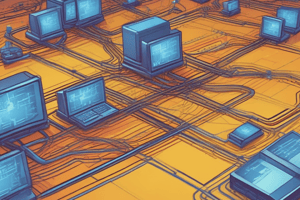Podcast
Questions and Answers
What happens when R1 receives a packet from W1 that exceeds its M2?
What happens when R1 receives a packet from W1 that exceeds its M2?
- R1 sends a request to W1 to adjust the packet size
- R1 immediately sends back an ICMP message to W1
- R1 tries to fragment the packet into smaller packets (correct)
- R1 sends the packet back to W1 without changing it
What is the purpose of the DF bit in IP version 4?
What is the purpose of the DF bit in IP version 4?
- To disallow packet fragmentation (correct)
- To reduce packet size
- To allow packet fragmentation
- To increase packet size
What happens when R1 receives a packet from W1 that exceeds its M2 with DF bit set to 1?
What happens when R1 receives a packet from W1 that exceeds its M2 with DF bit set to 1?
- R1 sends a packet back to W1 to reduce the packet size
- R1 sends back an ICMP fragmentation needed and DF set message (correct)
- R1 ignores the packet
- R1 tries to fragment the packet
What is M2 Path Discovery in IPV6?
What is M2 Path Discovery in IPV6?
What happens when the IPV6 sender receives an ICMP message indicating packet too big?
What happens when the IPV6 sender receives an ICMP message indicating packet too big?
What is the main difference between IPV4 and IPV6 in terms of packet handling?
What is the main difference between IPV4 and IPV6 in terms of packet handling?
What happens when R1 receives a packet from W1 that is smaller than its M2?
What happens when R1 receives a packet from W1 that is smaller than its M2?
What is the purpose of the ICMP message in this scenario?
What is the purpose of the ICMP message in this scenario?
What is the consequence of setting the DF bit to 1 in IPV4?
What is the consequence of setting the DF bit to 1 in IPV4?
What is the main advantage of M2 Path Discovery in IPV6?
What is the main advantage of M2 Path Discovery in IPV6?
What is the primary function of an M2 in a network device?
What is the primary function of an M2 in a network device?
What is the difference between an M2 at layer two and an M2 at layer three?
What is the difference between an M2 at layer two and an M2 at layer three?
What would happen if the M2 on Router R1 is smaller than the M2 on Switch SW1?
What would happen if the M2 on Router R1 is smaller than the M2 on Switch SW1?
Why is it a best practice to reduce the M2 on a PGP link?
Why is it a best practice to reduce the M2 on a PGP link?
What is the purpose of the Ethernet header in an M2 calculation?
What is the purpose of the Ethernet header in an M2 calculation?
What happens if the M2 on Router R1 is not matched with the M2 on Switch SW1?
What happens if the M2 on Router R1 is not matched with the M2 on Switch SW1?
What is the relationship between the M2 on Router R1 and Switch SW1?
What is the relationship between the M2 on Router R1 and Switch SW1?
What is the main benefit of having matching M2 sizes on both sides of a link?
What is the main benefit of having matching M2 sizes on both sides of a link?
What would happen if the packet size exceeds the M2 on Router R1?
What would happen if the packet size exceeds the M2 on Router R1?
What is the purpose of the M2 in a network device?
What is the purpose of the M2 in a network device?
Study Notes
Maximum Transmission Unit (MTU)
- MTU is the largest frame or packet that can be transmitted or received on an interface, applicable to any network device.
- MTU can be identified at Layer 2 (frames) or Layer 3 (packets).
MTU Example
- Router R1 has an MTU of 1500 bytes for packets (Layer 3) and 1518 bytes for frames (Layer 2), considering an 18-byte Ethernet header.
- Matching MTUs on both sides of a link (R1 and SW1) ensure proper communication.
Consequences of Mismatched MTUs
- If R1 has a smaller MTU than SW1, packets exceeding R1's MTU will be dropped, and an ICMP "fragmentation needed and DF set" message will be sent back to SW1.
Reducing MTU Size
- In Point-to-Point Protocol over Ethernet (PPPoE), the MTU may be reduced by 8 bytes to accommodate the PPPoE header, resulting in a packet size of 1492 bytes.
IPv4 and IPv6 Differences
- In IPv4, the Don't Fragment (DF) bit is set to 1, disallowing packet fragmentation.
- In IPv6, there is no DF bit, and the receiver sends a "packet too big" ICMPv6 message to the sender.
- IPv6 supports MTU Path Discovery, allowing the sender to dynamically adjust packet size based on ICMPv6 feedback.
Studying That Suits You
Use AI to generate personalized quizzes and flashcards to suit your learning preferences.
Description
Learn about M2, the largest frame or packet that can be transmitted or received on an interface, and how it applies to network devices at layer 2 and 3.




